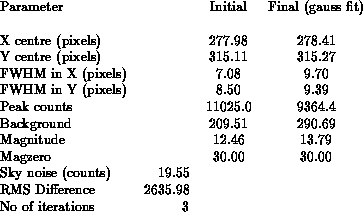Previous: MOVESTAR - Put an object on to a specified area of the chip
Up: LEXIDATA DISPLAY OPERATIONS
Previous Page: MOVESTAR - Put an object on to a specified area of the chip
Next Page: DATA FILE CONTROL
Previous: MOVESTAR - Put an object on to a specified area of the chip
Up: LEXIDATA DISPLAY OPERATIONS
Previous Page: MOVESTAR - Put an object on to a specified area of the chip
Next Page: DATA FILE CONTROL
The prime purpose of this program is to do Gaussian fits to stellar images to provide estimates of FWHM etc.
Of course, the stellar images are not Gaussian, but the program was initially conceived as a way of providing a faster and more objective method of finding the best telescope focus after a FOCUS run. The advantage of the fitting program is that all the data in the image are used to estimate the FWHM, not just the particular row or column you happened to select with the Lexidata cursor.
To invoke the program, type STARFIT. The program works similarly to PHOTOM in many respects, being operated exclusively by the Lexidata switches and joystick. The various switches are described below.
EXIT - operating this simply exits from the program.
RESET - clears the overlays and resets the program to its starting condition.
UP - each time this switch is operated the Lexidata cursor increases in size by 2 pixels.
DOWN - the opposite of UP, it decreases the Lexidata cursor by 2 pixels.
READ - reads the current cursor position and performs an operation that depends entirely on the currently selected MODE.
MODE - each time this switch is operated the program switches to a new mode. There are five modes as described below.
Example
Point No 1 Pixel coords 279, 314 Counts = 8416

The initial estimates are just those you would get with PHOTOM if you did
profiles of and
through the peak pixel values within the box.
Similarly, the background, magnitude and sky noise are those you would get
if you used the STATS option in PHOTOM. The size of the RMS difference in
relation to the sky noise gives an indication if how good the fit is.
There are three points that should be noted.